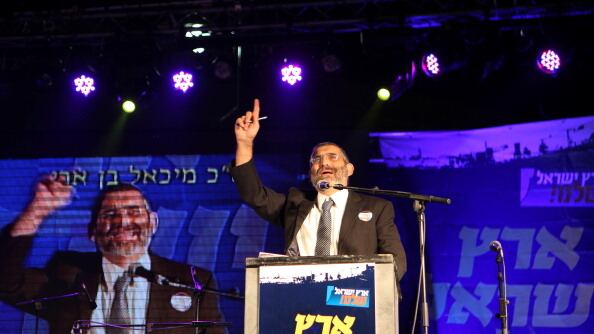Last week, some four hundred followers—around 300 men, 100 women—marked Rabbi Meir Kahane's death in a dilapidated wedding hall in a poor religious neighborhood in Jerusalem. The lighting was poor, the food was cheap, but the guests were hardcore. Bentzi Gupstein, a graduate of the Kach movement and Kiryat Arba settler, announced that they picked the place it was where Kahane always held his public events. It is, he claimed, the only place in Jerusalem “where they never let Arabs in.”
These are the folks—Mikhael Ben-Ari, Baruch Marzel and Itamar Ben Gvir—who brought you Neighborhood Watch (to keep out “infiltrators”) and Lehava (to prevent intermarriage between Jews and non-Jews). They boo Shelly Yachimovitch and tear up photos of Ahmed Tibi on stage (yes, both happened at the rally). They demand the return both banks of the Jordan River. They will almost certainly make it into Knesset.

Yesterday marked the yortzheit (death day) of Kahane, founder of the Jewish Defense League and the now-illegal Kach party, which was banned from the Knesset in the 1980s and declared a terrorist organization by the Israeli government in 1994. On November 5, 1990—22 years ago yesterday—a man named El Sayyid Nosair, an Egyptian born American citizen, probably assassinated Meir Kahane. I say probably because the jury failed to convict him. But the circumstances of his murder aside, Kahane lives on. In children.
A high school vibe overtook the hall: it was a pep rally, complete with its own music video—“Kahana was right,” laments the ditty. It was an opportunity for Kahanist politicians to pat themselves on the back. Mikhael Ben Ari, a current Kahanist member of the Knesset, announced that his new ultra-right breakaway party (which runs under the disturbing slogan “The only ones who speak Arabic”) is expected to get 7 or 8 seats (though polls show that it’s more likely to get about two).
But beyond politics and policy, the rally was really about tutelage. The official program was interspersed with three 10-minute clips from “Kahane for Kids” (Hebrew)—a new animated film where kids “discover” Kahane. The protagonist was a little boy named Meir David, named after Kahane. The villains were black-faced, monkey-like thugs who beat up Jews on the streets of Brooklyn, and the heroes were, of course, Mikhael Ben-Ari, Baruch Marzel and Meir Kahane. Gupstein announced the purpose of the video: “In essence, to bequeath to the next generation who Kahane was,” so that they can “absorb” his teachings.
Gupstein lives in Kiryat Arba and, because I got to the event early yesterday, I met his daughter—she’s eighteen or nineteen (national service age), has a dyed white-blond streak in her long black hair, and she’s a doer. She enlisted a bunch of girls, including myself, to carrying overflowing bags of Kahane T-shirts up to the event vans below. She is an activist in the brand-new youth-led project: “Returning to the Mount.” Which Mount? The Temple Mount.
Before Mikhael Ben-Ari spoke, he was asked to hand out the newly published book of Kahane’s writings to a group of high school students—boys in massive skullcaps and long unruly side locks—in recognition of their participation in a study group in Migron, a now-evacuated illegal outpost in the northern West Bank. Between the speeches by settlement Rabbis and political activists, two girls got up and talked about how they were forming a new youth movement—their first activity, they said, was a writing competition asking members the question: “what would the Macabees have done about the Temple Mount had they lived in our time?”
Itamar Ben Gvir, who, in his youth, had been a member of the now-defunct Kahanist Youth Movement (in Hebrew the acronym non-ironically spells “Tanach” or “Bible”) put his message to the youngsters this way:
We acted. And we didn’t ask too many questions… We have the ability to influence, and this is why the youth need to come—every one and his particular influence, each one and his particular vocation… to learn from Rav Kahane self-sacrifice… and fearlessness; to decide something and to stick to it until the end. Not to fear, and to do.
Call Kahanists fascists, call them racists, but they stick to their guns. This, the new generation of Baruch Goldsteinsand Yoel Lerners, is imbibing the doctrine of truth, fearlessness and xenophobia. They’re not afraid. I am.






